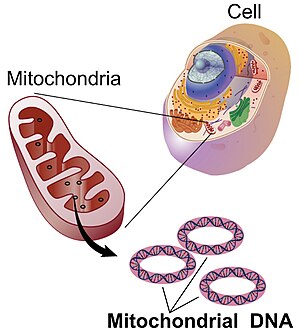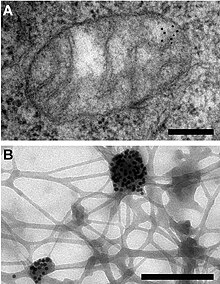مائيٽوڪونڊريل ڊي اين اي
مائٽوڪونڊريل ڊي اين اي (Mitochondrial DNA)، مختصر طور تي ايم ٽي ڊي اين اي (mtDNA) ۽ ايم ڊي اين اي(mDNA)، ڊي اين اي (DNA) آهي جيڪو مائٽوڪونڊريا آرگنيلز ۾ يوڪريٽائ جيو گھرڙن ۾ واقع آهي جيڪو ڪيميائي توانائي کي کاڌي مان ايڊينوسائن ٽرائيفاسفيٽ (ATP) ۾ تبديل ڪري ٿو. مائٽوڪونڊريل ڊي اين اي، ڊي اين اي (DNA) جو ھڪڙو ننڍڙو حصو آھي جيڪو يوڪريوٽڪ جيو گھرڙن ۾ ملي ٿو. گهڻو ڪري ڊي اين اي جيو گھرڙي جي نيوڪلئس ۾ هوندو آهي ۽ ٻوٽن ۽ الجائي ۾ ڊي اين اي پلاسٽڊ، جهڙوڪ ڪلوروپلاسٽ، ۾ پڻ ملي ٿو.[2]


Human mitochondrial DNA was the first significant part of the human genome to be sequenced.[3] This sequencing revealed that human mtDNA has 16,569 base pairs and encodes 13 proteins. As in other vertebrates, the human mitochondrial genetic code differs slightly from nuclear DNA.[4]
Since animal mtDNA evolves faster than nuclear genetic markers,[5][6][7] it represents a mainstay of phylogenetics and evolutionary biology. It also permits tracing the relationships of populations, and so has become important in anthropology and biogeography.
پڻ ڏسو
سنواريوخارجي لنڪس
سنواريو- وڪيميڊيا العام تي مائيٽوڪونڊريل ڊي اين اي بابت زمرا
حوالا
سنواريو- ↑ "The functional organization of mitochondrial genomes in human cells". BMC Biology 2: 9. May 2004. doi:. PMID 15157274.
- ↑ Sykes B. "Mitochondrial DNA and human history". The Human Genome. Wellcome Trust. وقت 7 September 2015 تي اصل کان آرڪائيو ٿيل. حاصل ڪيل 5 February 2012.
- ↑ "Sequence and organization of the human mitochondrial genome". Nature 290 (5806): 457–465. April 1981. doi:. PMID 7219534. Bibcode: 1981Natur.290..457A.
- ↑ Chinnery, Patrick Francis; Hudson, Gavin (June 2013). "Mitochondrial genetics". British Medical Bulletin 106 (1): 135–159. doi:. ISSN 0007-1420. PMID 23704099. PMC 3675899. https://www.ncbi.nlm.nih.gov/pmc/articles/PMC3675899/.
- ↑ "[Not Available]". Génétique, Sélection, Évolution 18 (1): 73–98. 1986-01-01. doi:. PMID 22879234.
- ↑ "Molecular systematics of armadillos (Xenarthra, Dasypodidae): contribution of maximum likelihood and Bayesian analyses of mitochondrial and nuclear genes". Molecular Phylogenetics and Evolution 28 (2): 261–275. August 2003. doi:. PMID 12878463. Bibcode: 2003MolPE..28..261D. https://hal.archives-ouvertes.fr/halsde-00192983. Retrieved 4 November 2018.
- ↑ "Combining multiple autosomal introns for studying shallow phylogeny and taxonomy of Laurasiatherian mammals: Application to the tribe Bovini (Cetartiodactyla, Bovidae)". Molecular Phylogenetics and Evolution 66 (3): 766–775. March 2013. doi:. PMID 23159894. Bibcode: 2013MolPE..66..766H.